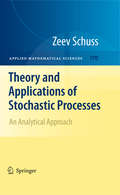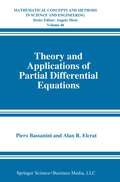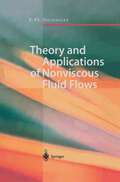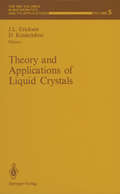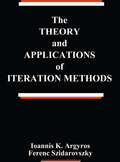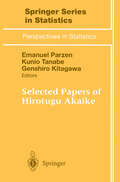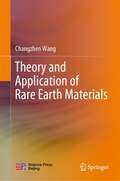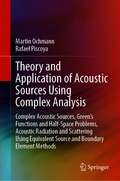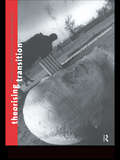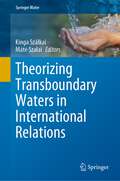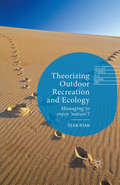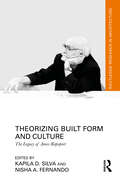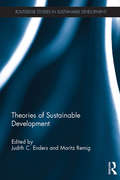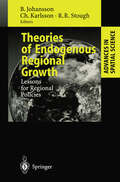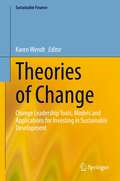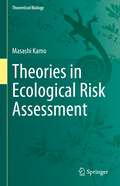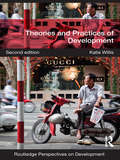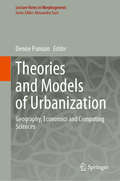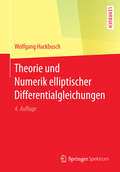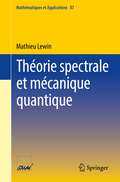- Table View
- List View
Theory and Applications of Stochastic Processes: An Analytical Approach (Applied Mathematical Sciences #170)
by Zeev SchussStochastic processes and diffusion theory are the mathematical underpinnings of many scientific disciplines, including statistical physics, physical chemistry, molecular biophysics, communications theory and many more. Many books, reviews and research articles have been published on this topic, from the purely mathematical to the most practical. This book offers an analytical approach to stochastic processes that are most common in the physical and life sciences, as well as in optimal control and in the theory of filltering of signals from noisy measurements. Its aim is to make probability theory in function space readily accessible to scientists trained in the traditional methods of applied mathematics, such as integral, ordinary, and partial differential equations and asymptotic methods, rather than in probability and measure theory.
Theory and Applications of Partial Differential Equations (Mathematical Concepts and Methods in Science and Engineering #46)
by Piero Bassanini Alan R. ElcratThis book is a product of the experience of the authors in teaching partial differential equations to students of mathematics, physics, and engineering over a period of 20 years. Our goal in writing it has been to introduce the subject with precise and rigorous analysis on the one hand, and interesting and significant applications on the other. The starting level of the book is at the first-year graduate level in a U.S. university. Previous experience with partial differential equations is not required, but the use of classical analysis to find solutions of specific problems is not emphasized. From that perspective our treatment is decidedly theoretical. We have avoided abstraction and full generality in many situations, however. Our plan has been to introduce fundamental ideas in relatively simple situations and to show their impact on relevant applications. The student is then, we feel, well prepared to fight through more specialized treatises. There are parts of the exposition that require Lebesgue integration, distributions and Fourier transforms, and Sobolev spaces. We have included a long appendix, Chapter 8, giving precise statements of all results used. This may be thought of as an introduction to these topics. The reader who is not familiar with these subjects may refer to parts of Chapter 8 as needed or become somewhat familiar with them as prerequisite and treat Chapter 8 as Chapter O.
Theory and Applications of Nonviscous Fluid Flows
by Radyadour K. ZeytounianFrom the reviews: "Researchers in fluid dynamics and applied mathematics will enjoy this book for its breadth of coverage, hands-on treatment of important ideas, many references, and historical and philosophical remarks." Mathematical Reviews
Theory and Applications of Liquid Crystals (The IMA Volumes in Mathematics and its Applications #5)
This IMA Volume in Mathematics and its Applications AMORPHOUS POLYMERS AND NON-NEWTONIAN FLUIDS is in part the proceedings of a workshop which was an integral part of the 1984-85 IMA program on CONTINUUM PHYSICS AND PARTIAL DIFFERENTIAL EQUATIONS We are grateful to the Scientific Committee: Haim Brezis Constantine Dafermos Jerry Eri cksen David Kinderlehrer for planning and implementing an exciting and stimulating year-long program. We espe cially thank the Program Organizers, Jerry Ericksen, David Kinderlehrer, Stephen Prager and Matthew Tirrell for organizing a workshop which brought together scientists and mathematicians in a variety of areas for a fruitful exchange of ideas. George R. Sell Hans Weinberger Preface The diversity of experimental phenomena and the range of applications of liquid crystals present timely and challenging questions for experimentalists, mechanists, and mathematicians. The scope of this workshop was to bring together research workers and practitioners in these areas from laboratories, industry, and universities to explore common issues. The contents of this volume vary from descriptions of experimental phenomena, of which our understanding is insufficient, to questions of a mathematical nature and of efficient computation.
The Theory and Applications of Iteration Methods (Systems Engineering Ser.)
by Ioannis K. Argyros Ferenc SzidarovszkyThe Theory and Applications of Iteration Methods focuses on an abstract iteration scheme that consists of the recursive application of a point-to-set mapping. Each chapter presents new theoretical results and important applications in engineering, dynamic economic systems, and input-output systems. At the end of each chapter, case studies and numerical examples are presented from different fields of engineering and economics. Following an outline of general iteration schemes, the authors extend the discrete time-scale Liapunov theory to time-dependent, higher order, nonlinear difference equations. The monotone convergence to the solution is examined in and comparison theorems are proven . Results generalize well-known classical theorems, such as the contraction mapping principle, the lemma of Kantorovich, the famous Gronwall lemma, and the stability theorem of Uzawa. The book explores conditions for the convergence of special single- and two-step methods such as Newton's method, modified Newton's method, and Newton-like methods generated by point-to-point mappings in a Banach space setting. Conditions are examined for monotone convergence of Newton's methods and their variants. Students and professionals in engineering, the physical sciences, mathematics, and economics will benefit from the book's detailed examples, step-by-step explanations, and effective organization.
The Theory and Applications of Iteration Methods
by Ioannis K. Argyros Ferenc SzidarovszkyThe Theory and Applications of Iteration Methods focuses on an abstract iteration scheme that consists of the recursive application of a point-to-set mapping. Each chapter presents new theoretical results and important applications in engineering, dynamic economic systems, and input-output systems. At the end of each chapter, case studies and numerical examples are presented from different fields of engineering and economics. Following an outline of general iteration schemes, the authors extend the discrete time-scale Liapunov theory to time-dependent, higher order, nonlinear difference equations. The monotone convergence to the solution is examined in and comparison theorems are proven . Results generalize well-known classical theorems, such as the contraction mapping principle, the lemma of Kantorovich, the famous Gronwall lemma, and the stability theorem of Uzawa. The book explores conditions for the convergence of special single- and two-step methods such as Newton's method, modified Newton's method, and Newton-like methods generated by point-to-point mappings in a Banach space setting. Conditions are examined for monotone convergence of Newton's methods and their variants. Students and professionals in engineering, the physical sciences, mathematics, and economics will benefit from the book's detailed examples, step-by-step explanations, and effective organization.
Theory and Applications of Drilling Fluid Hydraulics (Exlog Series of Petroleum Geology and Engineering Handbooks #1)
by EXLOG/WhittakerThe objectives of this book are (1) to serve as a reasonably comprehensive text on the subject of drilling hydraulics and (2) to provide the field geologist with a quick reference to drilling hydraulics calculations. Chapter 1 introduces the basic principles of fluid properties, and Chapter 2 presents the general principles of fluid hydraulics. Chapters 3 through 10 analyze specific hydraulic considerations of the drilling process, such as viscometric measurements, pressure losses, swab and surge pressures, cuttings transport and hydraulic optimization. References are presented at the end of each section. The units and nomenclature are consistent throughout the manual. Equations are given generally in consistent S.1. units; some common expressions are also given in oilfield units. Nomenclature is explained after every equation when necessary, and a comprehensive list of the nomenclature used is given in Appendix A. Units are listed in Appendix B. In Appendix C, all the important equations are given in both S.1. and oilfield units. Appendix D contains example hydraulics calculations. A glossary is included. THEORY AND APPLICATION OF DRILLING FLUID HYDRAULICS 1 INTRODUCTION To dri 11 a we 11 safely and succes sfull y depends upon a thorough unders tandi ng of drilling hydraulics principles. Thus, drilling hydraulics is a very impor tant subject with which all logging geologists should be familiar.
Theory and Application of Rare Earth Materials
by Changzhen WangThis book starts with a theoretical introduction of the rare earth materials, and it subsequently analyzes the essential characteristics of these materials from elements, compounds to physical chemistry and metal materials, etc. Under the supplementary explanation of experimental data and results, the research is gradually guided into the multi-domain application scene. Through extensive analyses, this book displays comprehensively the distinguished values of the rare earth materials and the theoretical, empirical, and practical significance of rare earth materials is unraveled. It also covers an exhaustive review of 17 rare earth elements, their characteristics, and more possibilities in physical chemistry, functional materials, metallurgy, composites and engineering, and their prospects in production and technical applications. In-depth account of the whole spectrum of rare earth material research makes this book a unique reference to academic researchers, students, and engineers.
Theory and Application of Acoustic Sources Using Complex Analysis: Complex Acoustic Sources, Green’s Functions and Half-Space Problems, Acoustic Radiation and Scattering Using Equivalent Source and Boundary Element Methods
by Martin Ochmann Rafael PiscoyaThis book highlights the mathematical and physical properties of acoustical sources with singularities located in the complex plane and presents the application of such special elements to solve acoustical radiation and scattering problems. Sources whose origin lies in the complex plane are also solutions of the wave equation but possess different radiating properties as their counterparts with real positions. Such mathematical constructions are known in the fields of optics and electrodynamics, but they are not common in acoustical research. The objective of the book is to introduce this concept to acousticians and motivate them to engage themselves in further research and application of complex sources. Such sources are particularly useful to formulate Green’s functions and related equivalent source and boundary element methods in half-spaces.
Theorizing Transition: The Political Economy of Post-Communist Transformations
by John Pickles Adrian SmithTheorizing Transition provides a comprehensive examination of the economic, political, social and cultural transformations in post-Communist countries and an important critique of transition theory and policy. The authors create the basis of a theoretical understanding of transition in terms of a political economy of capitalist development. The diversity of forms and complexities of transition are examined through a wide range of examples from post-Soviet countries and comparative studies from countries such as Vietnam and China. Theorizing Transition challenges many of the comfortable assumptions unleashed by the euphoria of democratisation and the triumphalism of market capitalism in the early 1990s and shows transition to be much more complex than mainstream theory suggests.
Theorizing Transition: The Political Economy of Post-Communist Transformations
by John Pickles Adrian SmithTheorizing Transition provides a comprehensive examination of the economic, political, social and cultural transformations in post-Communist countries and an important critique of transition theory and policy. The authors create the basis of a theoretical understanding of transition in terms of a political economy of capitalist development. The diversity of forms and complexities of transition are examined through a wide range of examples from post-Soviet countries and comparative studies from countries such as Vietnam and China. Theorizing Transition challenges many of the comfortable assumptions unleashed by the euphoria of democratisation and the triumphalism of market capitalism in the early 1990s and shows transition to be much more complex than mainstream theory suggests.
Theorizing Transboundary Waters in International Relations (Springer Water)
by Kinga Szálkai Máté SzalaiThis book is the first collection of state-of-the-art research projects analyzing water conflict and cooperation with an explicitly theoretical point of view. Its fourteen chapters offer a comprehensive and up-to-date overview on how the application of various theoretical perspectives can support the work of scholars and practitioners in mitigating water conflict and developing cooperation.The volume starts out from a literature review on the theorization of transboundary waters in International Relations, which prepares the ground for the demonstration of the latest approaches of scholars currently working on this field. The discussion of their findings is divided into four main sections. The first section deals with reflections and critiques on the grand theories of International Relations, proposing new and more nuanced frameworks for understanding and managing transboundary water relations by going beyond the traditional assumptions. The second section focuses on the catalysts and barriers of cooperation, applying theoretical frameworks which reveal the consequences of the dynamics in power relations and institutional frameworks. The third section investigates into the perspectives at the intersections of theory and practice related to the most practical field within the scope of the volume: water diplomacy. The fourth section introduces new perspectives to provide specific entry points for understanding and managing water conflict and cooperation.Overall, the work intends to demonstrate that the theorization of transboundary waters can significantly contribute to the deeper understanding and the more efficient management of water conflicts and cooperation from several aspects.The authors come from diverse backgrounds, and their individual careers are often related to the intersections of theory and practice in the field of transboundary water management. Their expertise covers water issues from all around the globe, which is reflected in the range of the analyzed case studies. The diversity of the experts involved, their backgrounds, their perspectives, the applied theories, and the analyzed cases was an important priority for the editors.
Theorizing Outdoor Recreation and Ecology (Leisure Studies in a Global Era)
by Sean RyanDeciding what user impacts are natural or unnatural has inspired much debate. Biophysically, moose cause similar kinds of soil and vegetation impacts as hikers. Yet moose are the sign of nature while hikers are the sign of damage. The field of outdoor recreation is beset with paradoxes, and this book presents a unique, alternative framework to address these dilemmas. Examining outdoor recreation through the lens of ecological theory, Ryan draws from theorists such as Foucault, Derrida and Latour. The book explores minimum impact strategies designed to protect and enhance ecological integrity, but that also require a disturbing amount of policing of users, which runs counter to the freedom users seek. Recent ecological theory suggests that outdoor recreation's view of nature as balanced when impacts are removed is outdated and incorrect. What is needed, and indeed Ryan presents, is a paradoxical and ecological view of humans as neither natural nor unnatural, a view that embraces some traces in nature.
Theorizing Built Form and Culture: The Legacy of Amos Rapoport (Routledge Research in Architecture)
by Kapila D. Silva Nisha A. FernandoIn this collection of essays, Theorizing Built Form and Culture: The Legacy of Amos Rapoport – a felicitation volume to celebrate the significance of Professor Amos Rapoport's lifelong scholarship – scholars from around the world discuss the analytical relevance, expansion, and continuing application of these contributions in developing an advanced understanding of mutual relationships between people and built environments across cultures.Professor Amos Rapoport has espoused an intellectual and theoretical legacy on environmental design scholarship that explains how cultural factors play a significant role in the ways people create and use environments as well as the way environments, in turn, influence people’s behavior. This volume presents a hitherto-not-seen, unique, and singular work that simultaneously articulates a cohesive framework of Rapoport’s architectural theories and demonstrates how that theoretical approach be used in architectural inquiry, education, and practice across environmental scales, types, and cultural contexts. It also acknowledges, for the very first time, how this theoretical legacy has pioneered the decolonizing of the Eurocentric approaches to architectural inquiry and has thus privileged an inclusive, cross-cultural perspective that laid the groundwork to understand and analyze non-Western design traditions. The book thus reflects a wide range of cross-cultural and cross-contextual range to which Professor Rapoport’s theories apply, a general notion of theoretical validity he always advocated for in his own writings.The volume is a paramount source for scholars and students of architecture who are interested in understanding how culture mediates the creation, use, and preservation of the built environment.
Theorizing Built Form and Culture: The Legacy of Amos Rapoport (Routledge Research in Architecture)
In this collection of essays, Theorizing Built Form and Culture: The Legacy of Amos Rapoport – a felicitation volume to celebrate the significance of Professor Amos Rapoport's lifelong scholarship – scholars from around the world discuss the analytical relevance, expansion, and continuing application of these contributions in developing an advanced understanding of mutual relationships between people and built environments across cultures.Professor Amos Rapoport has espoused an intellectual and theoretical legacy on environmental design scholarship that explains how cultural factors play a significant role in the ways people create and use environments as well as the way environments, in turn, influence people’s behavior. This volume presents a hitherto-not-seen, unique, and singular work that simultaneously articulates a cohesive framework of Rapoport’s architectural theories and demonstrates how that theoretical approach be used in architectural inquiry, education, and practice across environmental scales, types, and cultural contexts. It also acknowledges, for the very first time, how this theoretical legacy has pioneered the decolonizing of the Eurocentric approaches to architectural inquiry and has thus privileged an inclusive, cross-cultural perspective that laid the groundwork to understand and analyze non-Western design traditions. The book thus reflects a wide range of cross-cultural and cross-contextual range to which Professor Rapoport’s theories apply, a general notion of theoretical validity he always advocated for in his own writings.The volume is a paramount source for scholars and students of architecture who are interested in understanding how culture mediates the creation, use, and preservation of the built environment.
Theories of Sustainable Development (Routledge Studies in Sustainable Development)
by Judith C. Enders Moritz RemigWhile sustainability has become a buzzword in discussions about the environment and development, work on theories of sustainable development has received much less attention. However, theory is vital as understanding the origins and development of the concept is the key to achieving successful implementation of sustainability. This book offers an interdisciplinary collection of research articles on the theories of sustainable development, drawing on a wide range of subjects including history, politics, governance, complex systems, economics and philosophy. It advocates viewing sustainable development not only as the establishment of a permanent, globally practicable and future-capable mode of life and economics, but as a complex array of problems involving a wide range of social-scientific and humanistic disciplines. This innovative approach means that the book is oriented toward current problems, not toward the established academic boundaries, and it draws out lessons that are relevant for those studying and working in sustainability across the world. This book will be of great interest to researchers and students of sustainable development and environmental politics, as well as practitioners working with sustainable development in politics, business, administration, and civil society organizations.
Theories of Sustainable Development (Routledge Studies in Sustainable Development)
by Judith C. Enders Moritz RemigWhile sustainability has become a buzzword in discussions about the environment and development, work on theories of sustainable development has received much less attention. However, theory is vital as understanding the origins and development of the concept is the key to achieving successful implementation of sustainability. This book offers an interdisciplinary collection of research articles on the theories of sustainable development, drawing on a wide range of subjects including history, politics, governance, complex systems, economics and philosophy. It advocates viewing sustainable development not only as the establishment of a permanent, globally practicable and future-capable mode of life and economics, but as a complex array of problems involving a wide range of social-scientific and humanistic disciplines. This innovative approach means that the book is oriented toward current problems, not toward the established academic boundaries, and it draws out lessons that are relevant for those studying and working in sustainability across the world. This book will be of great interest to researchers and students of sustainable development and environmental politics, as well as practitioners working with sustainable development in politics, business, administration, and civil society organizations.
Theories of Endogenous Regional Growth: Lessons for Regional Policies (Advances in Spatial Science)
by Börje Johansson Charlie Karlsson Roger R. StoughDuring the last two decades a new growth theory has emerged - often labelled "endogenous economic growth". The contributions in the book develop these advances into a theoretical framework for endogenous regional economic growth and explain the implications for regional economic policies in the perspective of the new century. Endogenous growth models can reflect increasing returns and hence refer more adequately to empirical observations than earlier models, and the models become policy relevant, because in endogenous growth models policy matters. Such policies comprise efforts to stimulate the growth of knowledge intensity of the labour supply and knowledge production in the form of R&D.
Theories of Change: Change Leadership Tools, Models and Applications for Investing in Sustainable Development (Sustainable Finance)
by Karen WendtToday, it has become strikingly obvious that companies no longer operate in an environment where only risk return and volatility describe the business environment. The business has to deal with volatility plus uncertainty, plus complexity and ambiguity (VUCA): that requires new qualities, competencies, frameworks; and it demands a new mind set to deal with the VUCA environment in investment, funding and financing. This book builds on a new megatrend beyond resilience, called anti-fragility. We have had the black swan (financial crisis) and the red swan (COVID) - the Bank for International Settlement is preparing for regenerative capitalism, block chain based analysis of financial streams and is aiming to prevent the “Green Swan” – the climate crisis to lead to the next lockdown. In the light of the UN 17 Sustainable Development Goals, what is required, is Theories of Change.Written by experts working in the fields of sustainable finance, impact investing, development finance, carbon divesting, innovation, scaling finance, impact entrepreneurship, social stock exchanges, alternative currencies, Initial Coin Offerings (ICOs), ledger technologies, civil action, co-creation, impact management, deep learning and transformation leadership, the book begins by analysing existing Theories of Change frameworks from various disciplines and creating a new integrated model – the meta-framework. In turn, it presents insights on creating and using Theories of Change to redirect investment capital to sustainable companies while implementing the Sustainable Development Goals and the Paris Climate Agreement. Further, it discusses the perspective of planetary boundaries as defined by the Stockholm Resilience Institute, and investigates various aspects of systems, organizations, entrepreneurship, investment and finance that are closely tied to the mission ingrained in the Theory of Change. As it demonstrates, solutions that ensure the parity of profit, people and planet through dynamic change can effectively address the needs of entrepreneurs and business. By exploring these concepts and their application, the book helps create and shape new markets and opportunities.
Theories in Ecological Risk Assessment (Theoretical Biology)
by Masashi KamoThis book introduces various mathematical models used in ecological risk assessment, primarily discussing models used in hazard assessment. The book aims to link ecology and conservation biology with risk assessments, bringing together the knowledge of ecotoxicology and ecology for effective risk assessment. The first part describes population-level assessment in ecological risk assessment. The chapters cover current methodologies for ecological risk assessment, individual-level assessment, population dynamics models for population-level assessment, case studies, mathematical models for population extinctions, the derivation of mean time to extinction (MTE) and their case studies. The second part of the book discusses the mathematical models involved in hazard assessments. It introduces the method of risk assessment using species sensitivity distributions (SSDs), hazard assessment of metals, chemical mixtures using the Michaelis-Menten equation, basic elements of statistics and related topics. Expected readers are risk assessors in governments and public sectors, students and young researchers interested in environmental science. The book is made accessible and easy to follow by beginners in mathematical biology and theoretical ecology.
Theories and Practices of Development
by Katie WillisGlobal economic crisis and the implications of global environmental change have led academics and policy-makers to consider how ‘development’ in all parts of the world should be achieved. However, ‘development’ has always been a contested idea. While often presented as a positive process to improve people’s lives, the potential negative dimensions of ‘development’ on people and environments must also be recognized. Theories and Practices of Development provides a clear and user-friendly introduction to the complex debates around how development has been understood and achieved. The second edition has been fully updated and expanded to reflect global political and economic shifts, as well as new approaches to development. The rise of China and India is given particular attention, as is the global economic crisis and its implications for development theories and practice. There are new sections on faith-based development, and the development dimensions of climate change, as well as greater engagement with development theories as they are put into practice in the Global North. The book deals with the evolution of development ideas and policies, focusing on economic, political, social, environmental and spatial dimensions. It highlights how development cannot be considered as a neutral concept, but is entwined with inequalities in power at local, as well as national and global scales. The use of boxed examples, tables and illustrations helps students understand complex theoretical ideas and also demonstrates how development theories are put into practice in the real world. Each chapter ends with a summary section, discussion topics, suggestions for further reading and website resources.
Theories and Practices of Development (Routledge Perspectives on Development)
by Katie WillisGlobal economic crisis and the implications of global environmental change have led academics and policy-makers to consider how ‘development’ in all parts of the world should be achieved. However, ‘development’ has always been a contested idea. While often presented as a positive process to improve people’s lives, the potential negative dimensions of ‘development’ on people and environments must also be recognized. Theories and Practices of Development provides a clear and user-friendly introduction to the complex debates around how development has been understood and achieved. The second edition has been fully updated and expanded to reflect global political and economic shifts, as well as new approaches to development. The rise of China and India is given particular attention, as is the global economic crisis and its implications for development theories and practice. There are new sections on faith-based development, and the development dimensions of climate change, as well as greater engagement with development theories as they are put into practice in the Global North. The book deals with the evolution of development ideas and policies, focusing on economic, political, social, environmental and spatial dimensions. It highlights how development cannot be considered as a neutral concept, but is entwined with inequalities in power at local, as well as national and global scales. The use of boxed examples, tables and illustrations helps students understand complex theoretical ideas and also demonstrates how development theories are put into practice in the real world. Each chapter ends with a summary section, discussion topics, suggestions for further reading and website resources.
Theories and Models of Urbanization: Geography, Economics and Computing Sciences (Lecture Notes in Morphogenesis)
by Denise PumainThis book provides a thorough discussion about fundamental questions regarding urban theories and modeling. It is a curated collection of contributions to a workshop held in Paris on October 12th and 13th 2017 at the Institute of Complex Systems by the team of ERC GeoDiverCity. There are several chapters conveying the answers given by single authors to problems of conceptualization and modeling and others in which scholars reply to their conception and question them. Even, the chapters transcribing keynote presentations were rewritten according to contributions from the respective discussions. The result is a complete “state of the art” of what is our knowledge about urban processes and their possible formalization.
Theorie und Numerik elliptischer Differentialgleichungen
by Wolfgang HackbuschDas Verständnis der numerischen Behandlung elliptischer Differentialgleichungen erfordert notwendigerweise auch die Kenntnisse der Theorie der Differentialgleichungen. Deshalb behandelt das Buch beide parallel. Zunächst wird der klassische Zugang (starke Lösungen, Differenzenverfahren) beschrieben. Dem Maximum-Minimum-Prinzip auf der theoretischen Seite entsprechen beispielsweise die Eigenschaften der M-Matrizen, die sich bei der Diskretisierung ergeben. Nach einem Exkurs über die Funktionalanalysis werden die Variationsformulierung und die Finite-Element-Diskretisierungen behandelt. Weitere Themen sind die Analyse der Diskretisierungen von Eigenwertaufgaben und die Stokes-Gleichungen mit den inf-sup-Bedingungen für die Finite-Element-Diskretisierung. Auf der theoretischen Seite wird die Regularität der Lösungen näher untersucht.Gegenüber der zweiten Auflage enthält der vorliegende Text zahlreiche Aktualisierungen, vor allem im Bereich der Finiten Elemente sowie in den Literaturangaben. Außerdem wurden die vollständigen Lösungen der Übungsaufgaben hinzugefügt.
Théorie spectrale et mécanique quantique (Mathématiques et Applications #87)
by Mathieu LewinCe livre présente la théorie spectrale des opérateurs auto-adjoints en dimension infinie ainsi que son application à la mécanique quantique. Le concept d'auto-adjonction, découvert par John von Neumann dans les années 1930, est bien plus subtil dans ce cadre que pour les matrices hermitiennes en dimension finie. Cet ouvrage peut aussi servir d’introduction mathématique à la mécanique quantique. De multiples exemples physiques servent ainsi à illustrer et motiver les théorèmes plus abstraits. Les deux derniers chapitres présentent des résultats plus récents concernant l'équation de Schrödinger pour les atomes, les molécules et les solides. Aucune connaissance physique n'est cependant requise pour lire ces pages. Premier livre en français sur le sujet destiné aux étudiants de Master, ce livre pourra accompagner un cours à ce niveau. Il devrait aussi être utile aux lecteurs plus avancés désirant en savoir plus sur cette théorie. *** This book presents the spectral theory of self-adjoint operators on Hilbert space, with applications to quantum mechanics. The concept of self-adjointness in infinite dimension was discovered by John von Neumann in the 1930s and it is much more involved than in the case of Hermitian matrices in finite dimension. The book also provides an introduction to quantum mechanics, suitable for students with a mathematics background. The presentation provides numerous physical examples illustrating the abstract theory. The last two chapters present recent results on Schrödinger’s equation for systems of particles. No previous knowledge of physics is required for the book.Based on the author’s teaching and intended for graduate courses, this French language textbook can also serve as a useful introduction to the topic for more advanced readers.
